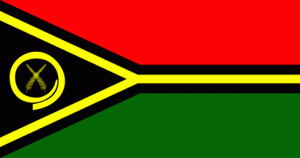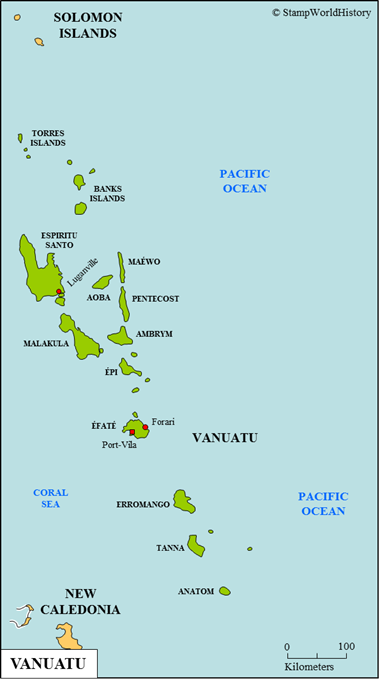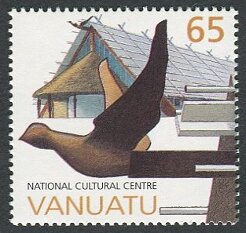
Vanuatu
Quick reference
General issues: Republic 1980-Present
Country name on general issues: Vanuatu
Currency: 1 (New Hebrides) Franc = 100 Centimes 1980-1981, 1 Vatu 1981-Present
Population: 115 000 in 1980, 272 000 in 2015
Political history Vanuatu
Vanuatu is an island nation located in the southwest Pacific Ocean. The indigenous population is Melanesian. The first European to explore the islands was the Portuguese explorer Pedro Fernández de Quirós. Sailing under the Spanish flag, De Quirós claimed the islands for Spain. The islands were again explored by the French explorer Louis-Antoine de Bougainville in 1768 and by the British explorer James Cook in 1774. Cook named the islands the New Hebrides. Until the late 19th century, contacts were sporadic and mainly focused on the – forced – recruitment of labor for plantations in the Americas, Australia, and elsewhere in the Pacific.
In the late 19th century, the islands were settled by both British – Australian – and French settlers. After a number of temporary administrative arrangements, the British and the French agreed to administer the islands as a condominium in 1906 – the condominium of the New Hebrides. The British and the French each set up their own administrations – essentially focused on the interests of the British and French citizens respectively. A joint administration also included local officials and administered general public services.
In the 1970’s, the call for independence grew louder. However, there was also opposition to independence. A faction on the island of Espiritu Santo forcibly opposed possible independence, supported by French planters and – reportedly – the French government. Forces from Papua New Guinea quelled the opposition and the New Hebrides gained independence as the republic of Vanuatu in 1980. Until today, Vanuatu society is divided along the lines of the English and French speaking parts of the population.
The indigenous population depended on small scale agriculture. The European planters developed cotton plantations and, later, switched to other cash crops of which coconuts was the most important. In the 20th century the small economy diversified to include fishing, tourism and off shore financial services. The United Nations qualify Vanuatu as one of the 48 least developed countries in the world.
Postal history Vanuatu
The first postal services to Vanuatu – then called the New Hebrides – were provided, in the 1880’s, by Australian and French steamer lines connecting the New Hebrides to Sydney, Australia and Nouméa, New Caledonia. Stamps of New South Wales were used from 1888 and a New South Wales post office was set up in 1892. A New Caledonia post office was set up in 1903 using the stamps of New Caledonia. The stamps of New South Wales and New Caledonia were superseded by the first issues of the condominium of the New Hebrides in 1908.
Vanuatu has issued stamps since 1980. The first issues, in 1980, continue the New Hebrides tradition of issues in English and French versions of identical design – the difference being the language used. Subsequent issues, in 1980 and 1981, are bi-lingual. Since 1982, only English is used on the stamps of Vanuatu. The issues of Vanuatu are a blend of issues with themes of national interest and themes aimed at the thematic collectors market.
Album pages
← Previous page: TuvaluNext page: Wallis & Futuna →



